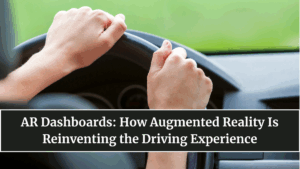The automotive world is experiencing a major shift toward augmented reality (AR) dashboards, bringing futuristic displays directly into today’s vehicles. By merging digital overlays with real-world visuals, AR dashboards enhance both safety and driving convenience. These systems project crucial data — like navigation, speed, and obstacle alerts — onto the windshield, allowing drivers to stay focused on the road ahead.

The Evolution of AR Dashboards
Initially seen in luxury models, AR dashboards are now becoming mainstream thanks to rapid tech advancements and falling costs. Brands like Mercedes-Benz, BMW, and Hyundai have already adopted head-up display (HUD) systems powered by AR. These displays use cameras, sensors, and onboard AI to interpret the surroundings and display real-time driving data seamlessly onto the glass, offering a blend of innovation, safety, and design sophistication.
How AR Enhances Safety and Navigation
Traditional dashboards can distract drivers with too much visual information. AR dashboards solve this by projecting context-aware visuals, such as lane guidance, pedestrian detection, and adaptive cruise control indicators. When approaching a turn, an AR arrow appears on the road ahead, showing exactly where to go — a step beyond conventional GPS. This intuitive navigation minimizes driver distraction and improves situational awareness, making roads safer for everyone.
Integration of AI and Real-Time Data
The magic of AR dashboards lies in AI integration. Vehicle cameras, LiDAR, and sensors constantly scan the environment to process data in milliseconds. This data helps identify hazards, monitor road signs, and even recognize traffic signals. By linking with cloud-based vehicle systems, AR dashboards also deliver live traffic updates and predictive warnings, ensuring the driver is always informed. The synergy between AI, sensors, and cloud computing marks a turning point in smart mobility.
The Rise of Personalized In-Car Experiences
AR dashboards are not just about data—they’re about personalized experiences. Drivers can customize the information they see: from fuel levels and tire pressure to entertainment options and voice assistance integration. In electric vehicles, for example, the dashboard might show battery range projections, charging station locations, and regenerative braking efficiency, adapting visuals based on the driver’s habits and preferences.
Challenges and Future of AR in Cars
Despite their benefits, AR dashboards face challenges like hardware costs, screen calibration, and data processing lag. Ensuring precise image alignment across varied lighting and weather conditions remains complex. However, continuous development in AR optics, projection technology, and cloud synchronization is addressing these issues rapidly. By 2025, industry analysts predict that over 30% of new vehicles will feature some form of AR-assisted display.
The Road Ahead
As automakers embrace AR dashboards 2025, the driving experience is set to become more immersive, intuitive, and connected than ever before. The line between the physical and digital world is blurring — transforming every car into a smart mobility ecosystem. For drivers, this means enhanced comfort, reduced risks, and a glimpse into the future of intelligent transportation.
FAQs
What is an AR dashboard in cars?
An AR dashboard uses augmented reality to display real-time driving information directly on the windshield or a transparent screen, allowing drivers to access data without looking away from the road.
How do AR dashboards improve safety?
They project visual cues such as lane guidance, pedestrian alerts, and turn directions directly in front of the driver’s view, reducing distractions and increasing awareness.
Which car brands are using AR dashboards?
Manufacturers like Mercedes-Benz (MBUX), BMW, Audi, and Hyundai have already introduced AR head-up displays in several 2024–2025 models.
What technologies power AR dashboards?
These systems use AI, sensors, LiDAR, cameras, and cloud data to process and display real-time visual overlays relevant to the driving environment.
Are AR dashboards available in budget cars?
While currently more common in premium vehicles, affordable models are expected to adopt simplified versions by 2025 as the technology becomes more cost-effective.
